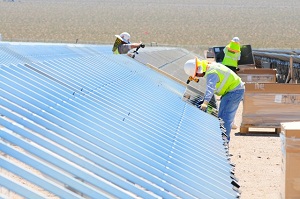Week in review: Consolidation in solar continues
 Last week in solar saw that solar continued to consolidate even as it is growing. Some analysts are saying now is a time for manufacturers to upgrade their production lines in anticipation of continued oversupply. Still there are signs that the industry is continuing to grow, and new parts of the industry are starting to take off, like building-integrated photovoltaics (BIPVs).
Last week in solar saw that solar continued to consolidate even as it is growing. Some analysts are saying now is a time for manufacturers to upgrade their production lines in anticipation of continued oversupply. Still there are signs that the industry is continuing to grow, and new parts of the industry are starting to take off, like building-integrated photovoltaics (BIPVs).
Shortly after a new report came out predicting that the solar manufacturing industry would see more consolidation, guess what, two companies have said they’re looking for buyers. Last week both Siemens and REC Solar said they’re interested in selling their solar business. Manufacturing giant Siemens said it would exit the photovoltaic and concentrated solar power business and was looking for buyers of both businesses as it seeks to become more profitable. Meanwhile Norway’s REC Solar following its recent earnings income results call said it is an ideal candidate for purchase.
The companies cited increased pricing pressure and oversupply as chief reasons for their interests in selling. Similarly, Colorado’s Abound Solar has cited cheap silicon PV pricing, particularly from Chinese manufacturers as one of the main reasons the company declared bankruptcy. But now the company finds itself under investigation as to whether it acted fraudulently when securing more investors and whether or not it knew products were defective. The company now is under investigation by Weld County, Col., District Attorney Ken Buck.
While the cheaper prices have wreaked havoc on companies trying to gain foothold in the industry, companies already established should consider taking the present to upgrade their equipment. That’s according to a new Lux Research report, “Turning lemons into lemonade: Opportunities in the turbulent photovoltaic equipment market”, which determined that now is an ideal time for such manufacturers to upgrade their equipment. The report contended that while such manufacturers are waiting for demand to reduce oversupply in the market, now is an ideal time for them to upgrade their manufacturing lines for more efficiency, so they can make more photovoltaics quicker and with higher efficiencies.
Other forms of solar are gaining traction as well. One such technology is BIPV, which is similar to regular PV but has a broader range of applications, like being built into a building’s wall or windows. A recent report from NanoMarkets predicted that between now and 2015 the BIPV market is expected to more than triple from a $2.1 billion industry to a $7.5 billion industry between now and 2015.
While most of the focus on the solar industry remains on PV, concentrated solar power also is making headway. For instance, BrightSource recently closed a new round of funding in excess of $80 million. The new round of funding will allow the company to move on future projects while pushing forward into more international markets.
While CSP has traditionally relied on a heat-transfer fluid to power a steam turbine, some are looking at alternatives, like superheating air. For instance, San Diego State University recently won a SunShot Initiative grant to support the next phase in development for its CSP technology, which will heat air and nano particles in the air to use the mixture in a turbine like a natural gas turbine as opposed to a steam turbine. The researchers behind the system realize that using water for power in a desert environment like those ideal for CSP, can be wasteful and air would be a better alternative.
One of the sticky wickets for what used to be the largest solar segment, commercial solar, has been how to best finance such installations. While the segment was the fastest growing for a long time, recently its been outpaced by residential and utility-scale solar in the U.S. To help make financing such projects easier Vote Solar is looking to champion a hybrid approach which already is being used. The approach combines aspects of property assessed clean energy (PACE) financing and third-party ownership (TPO).



